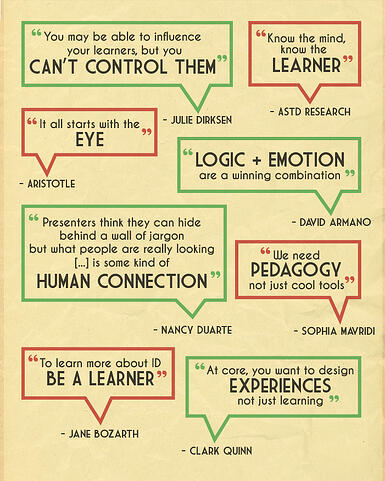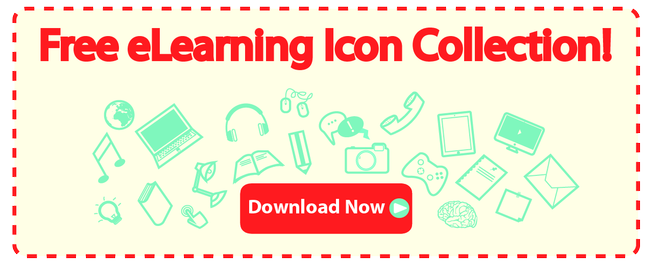 Whether you are just getting started with eLearning and looking to get a better understanding of eLearning best practices, or you've been creating courses for a while and are trying to find ways of making your material more effective, considering the basics of eLearning is key.
Whether you are just getting started with eLearning and looking to get a better understanding of eLearning best practices, or you've been creating courses for a while and are trying to find ways of making your material more effective, considering the basics of eLearning is key.
Before you start designing or re-designing be sure you put first things first. And that means getting into an eLearning mindset. It is very important for every eLearning professional seeking success to continuously work on their mindset. It's the mindset that determines the thinking and the thinking determines the actions taken.
Create effective eLearning courses by honoring these six ideas. These kind of thinking will support learning for a lifetime, no matter the topic.
“To learn more about ID, be a learner.” — Jane Bozarth
Training practitioner and instructional designer Jane Bozarth highly encourages professionals in the world of learning to become learners themselves. It’s the only way to truly understand learners—their pleasures and frustrations—and to get to know the dynamics of the learning process.
You’ll soon see the patterns of what works for you and what doesn’t. And you’ll not only realize that some courses are far better than the others, you’ll also know what makes them stand out.
“At core, you want to design experiences, not just learning.” — Clark Quinn
Clark Quinn, a renowned leader in learning technology strategy, embraces the powerful process of designing experiences. He dismisses the idea of merely creating a course or giving away content.
It’s never just about content, after all. It’s time for instructional designers to take their roles as “designers of learning experiences” seriously. If they can find ways to make the experience enjoyable or engaging, then learners are likely achieve their learning goals.
“We need pedagogy, not just cool tools.” —Sophia Mavridi
Sophia Mavridi, a senior EFL teacher, highlights the fact that technology isn’t a cure-all. There are cool tools, from Learning Management System software to specialized communication platforms, yes, but none can be considered as a technological silver bullet.
Your perpetual search for the next cool tool in eLearning may, in fact, distract you from your goal. What’s more, spending a lot on sophisticated but less than useful software is an expensive way to fail. This doesn’t mean technology isn’t useful. It can be useful when effectively deployed, that is, when you apply your skills and insights to the task.
“Know the mind, know the learner.” — ASTD Research
We’ve written a lot about the human brain lately. Our (and our readers’) fascination with the subject stemmed from our belief that in order to know the learners, we also have to know the mind.
How does the brain learn? How does it decode information and emotion? How should we design for the brain? We raised several questions this year, expect more brain-focus articles in the coming year.
“You may be able to influence your learners, but you can’t control them.” — Julie Dirksen
Adult learners want to take control of their lessons, to choose. While you can ask them to sign up, you can’t actually force them to learn. Julie Dirksen, author of Design for How People Learn, shares this nugget of information. She suggests professionals to respect adult learners by giving them “control over their learning environment.” Adults, you see, don’t like learning when they feel information, ideas or actions are imposed on them from the outside.
“It all starts with the eye.” —Aristotle
A visitor judges the value of a website in the link of an eye. Learners form their first impressions in 2.6 seconds, from the moment their eyes meet a specific spot on a page. It’s really all in the idea. The perception of value starts there, and we humans can’t help it. Learners simply can’t ignore what their eyes have seen. They have to decide what to do next: continue with the course or drop it.
“Logic + emotion are a winning combination. When useful and useable meet delight, great things happen. It’s about balance.” —David Armano
We value logic but tend to ignore emotion. Research, however, suggests that the most successful eLearning courses trigger the right emotions. They are proof that the learning process is an emotional one too. Emotion, in fact, is the brain’s secret language. When you evoke an emotion, the brain responds and decides, the body follows.
“Presenters think they can hide behind a wall of jargon, but what people are really looking for when they sit down at a presentation is some kind of human connection.” — Nancy Duarte
Learning has always been about connection. There’s the connection between concepts and ideas, between new and old knowledge, between teacher and student, between learners, and so on. But it’s ultimately about “human” connection, an experience similar to friends having a good conversation. Every participant listens, shares and gets something out of their participation.









